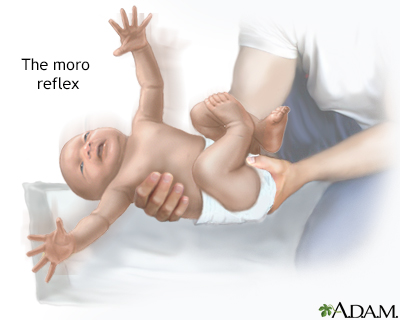
Have you ever watched your peacefully sleeping baby suddenly fling their arms out wide, then pull them back in with a jerk—only to wake themselves up in the process? That’s the startle reflex, a completely normal part of infancy that often disrupts sleep, leaving both babies and parents frustrated and exhausted.
But what exactly is the startle reflex, and what can you do about it? Let’s explore the science behind it, why it happens, and how you can help your baby sleep more soundly despite it.
What Is the Startle Reflex?
The startle reflex—technically known as the Moro reflex—is an automatic, involuntary response that all healthy newborns are born with. It typically appears at birth and fades by around 3 to 6 months of age.
Here’s what it looks like:
-
The baby suddenly flings their arms and legs outward.
-
They may arch their back or cry out.
-
Then they quickly bring their limbs back in toward their body.

This reflex is usually triggered by:
-
A loud noise
-
Sudden movement
-
A change in position (like being laid down too quickly)
-
Bright lights or other sensory input
How the Startle Reflex Affects Baby Sleep
While the Moro reflex is a sign of a healthy nervous system, it can make sleep especially challenging during the newborn months.
1. It Wakes Babies Mid-Nap or Night
The reflex can jolt your baby out of deep sleep, even if they were completely calm. These frequent wakings can lead to short naps, restless nights, and fussy days.
2. It Makes Falling Asleep Harder
Just as your baby is drifting off, a sudden startle can snap them back to full alertness. This can make it tough for babies to self-settle and extend their sleep stretches.
3. It Contributes to Overtiredness
Interrupted sleep leads to overtiredness, which ironically makes babies harder to settle and more prone to additional startles. It becomes a frustrating cycle for parents trying to establish good sleep habits.
How to Help Minimize the Startle Reflex During Sleep
You can’t stop the reflex itself—it’s a natural part of development—but you can take steps to reduce its impact.
✅ Swaddle Smartly
Swaddling is one of the most effective ways to reduce the impact of the startle reflex. A snug (but safe) swaddle keeps your baby’s arms from flailing outward and startling themselves awake.
-
Use a breathable cotton or bamboo swaddle.
-
Make sure it’s snug around the arms and loose at the hips.
-
Stop swaddling once your baby shows signs of rolling.
✅ Offer a Pacifier
Sucking can be soothing and help regulate your baby’s nervous system. A pacifier may help your baby fall back asleep more easily after a startle.
✅ Keep the Sleep Environment Calm
-
Use white noise to reduce the chance of loud sounds causing startles.
-
Keep the room dim during night wakings and naps.
-
Move your baby gently when laying them down—slow and steady helps prevent position-triggered reflexes.
✅ Try a Transitional Sleep Sack
When your baby outgrows the swaddle, a transitional sleep sack (like a Zipadee-Zip or Merlin’s Magic Sleepsuit) can provide gentle resistance against arm movement while still allowing freedom of movement for safety.
When Will It Go Away?
The good news is that the startle reflex is temporary. It typically begins to fade between 3 and 6 months of age, as your baby’s nervous system matures and they gain more control over their movements.
Until then, remember: it’s not something you’re doing wrong. It’s just a normal part of being a brand-new human.
Conclusion
The startle reflex can be frustrating for parents hoping for longer stretches of sleep—but it’s also a reassuring sign of a healthy, developing baby. With the right tools—like swaddling, white noise, and a consistent bedtime routine—you can help minimize disruptions and support your baby’s journey toward more peaceful, restorative sleep.
Hang in there: this phase is short-lived, but your calming presence has a lasting impact.
If you or someone you know struggles with sleep, please click the orange button below to take a free online sleep test and talk with one of our sleep health professionals.

